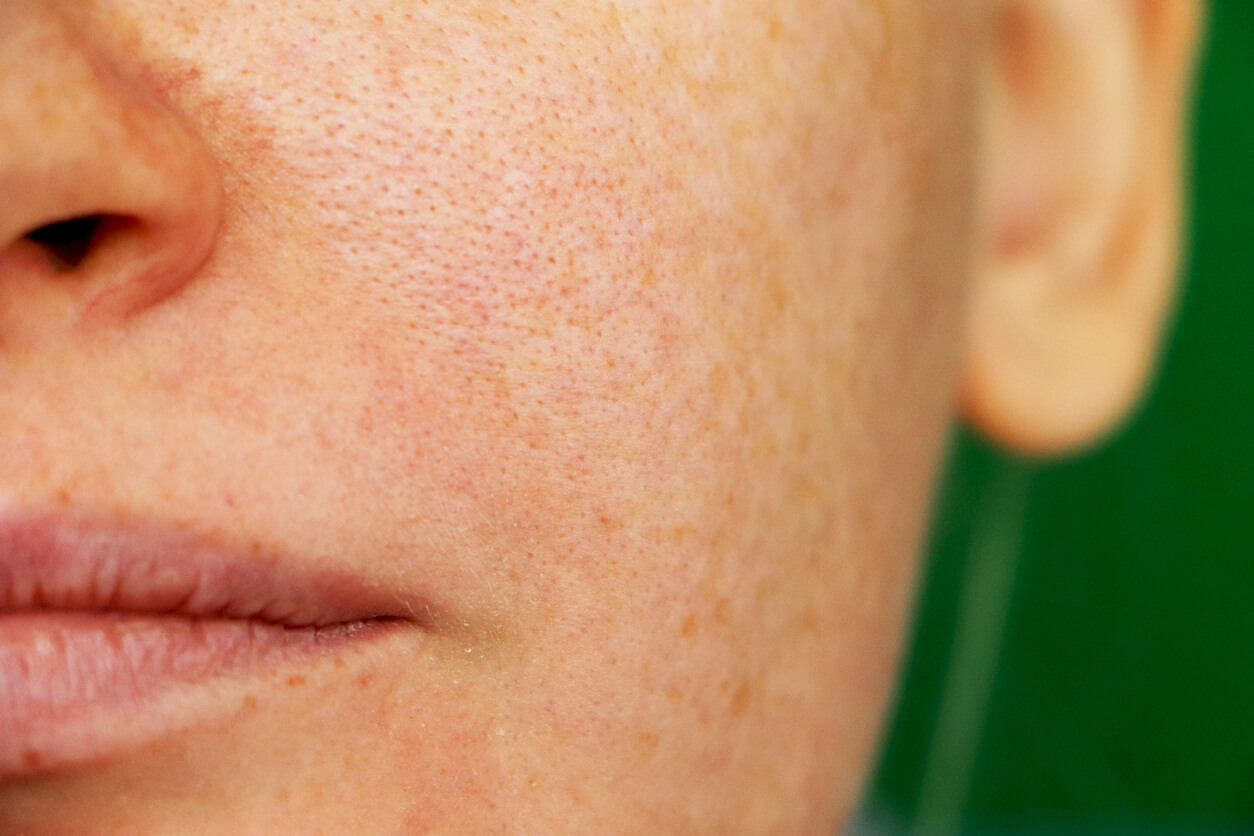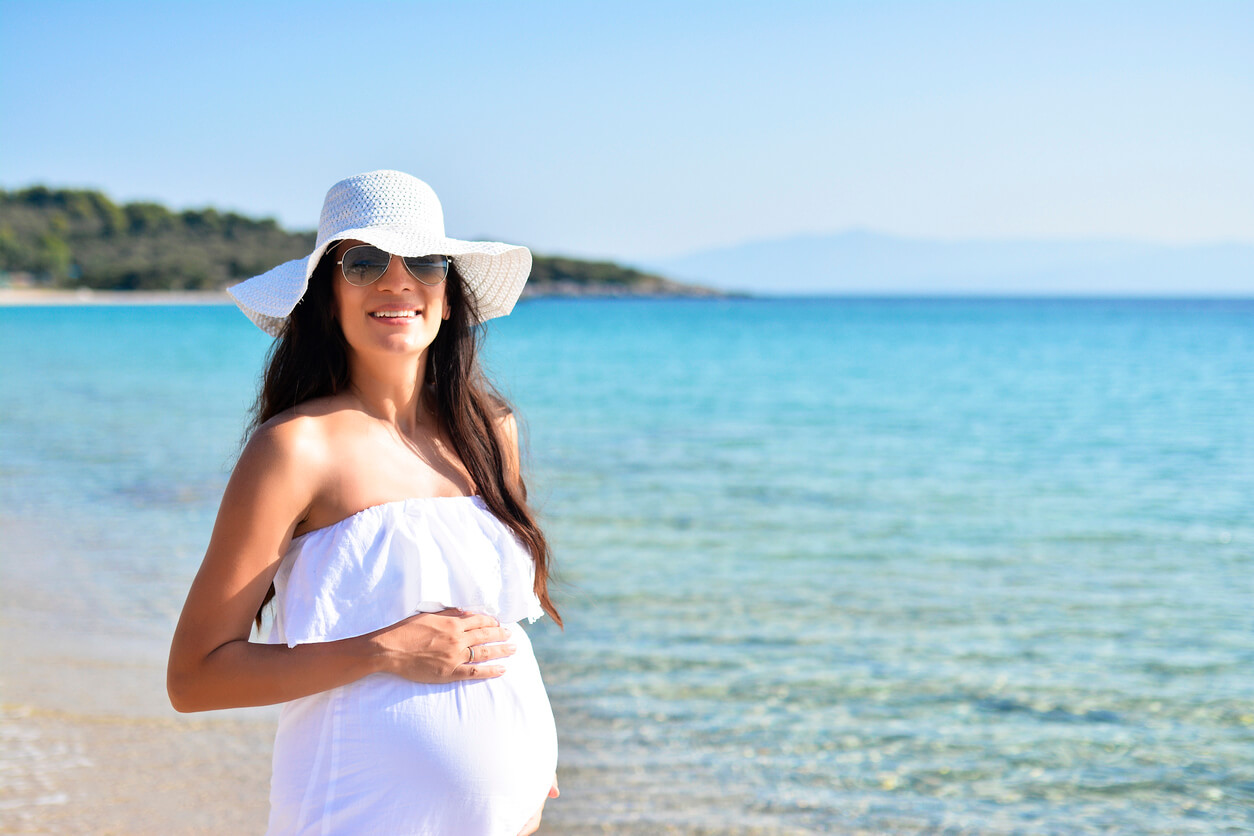Freckles During Pregnancy: What You Should Know

The appearance of freckles during pregnancy is one of the most common manifestations of this stage, as it’s associated with gestational hormonal changes. In fact, more than 90% of women present important and complex changes in their skin, which can have an impact on their daily life.
In addition to freckles, more evident spots can appear on the face of the mother-to-be, which can affect her self-esteem. So, today we’re going to tell you everything you should know about it and how to make your face look radiant. Don’t miss out!
Skin changes during pregnancy
Hormonal changes that develop during pregnancy stimulate the production of melanin, which is the pigment that gives color to the hair, eyes, and skin. Therefore, hyperpigmentation is one of the most common skin changes of pregnancy and manifests itself on different parts of the body.
The darkening of the skin begins in the first trimester of pregnancy, with an increase in the tone of already pigmented areas, such as the areola and vulva. Even freckles, moles, and recent scars darken and increase in size throughout pregnancy.

Gestational melasma
Melasma or chloasma, also known as “pregnancy mask” occurs in a high percentage of pregnant women. Between 15 and 50% of expectant mothers manifest it as an irregular, dark, and well-defined pigmentation on their faces, especially in the malar region and the center of the face.
Although these are transitory changes, a publication in the Brazilian Journal of Gynecology and Obstetrics suggests that this type of lesion can alter the quality of life of pregnant women. The appearance is very relevant for some people.
The hyperpigmented areas become darker when the skin is exposed to the sun or as pregnancy progresses. However, as mentioned above, chloasma spots, hyperpigmented scars, or new freckles from pregnancy may fade after delivery.
Should I consult a doctor if I get freckles during pregnancy?
Although the appearance of freckles or nevi during pregnancy is a fairly common phenomenon, it doesn’t mean that they don’t require medical control.
Although freckles very rarely develop into malignant lesions, if they cause bumps, bleed, or grow rapidly, it’s important to consult a dermatologist.
Skincare during pregnancy
Freckles during pregnancy can be exacerbated by sun exposure, the use of certain cosmetic products, or certain dermatological treatments. Therefore, prevention and skin care are the best strategies to improve the appearance of this tissue. Here are some simple, practical, and very useful recommendations.
Stay in the shade
The sun’s rays can trigger the production of more pigment, especially when exposure is prolonged over time. Therefore, expectant mothers are advised to stay in the shade during times of intense and harmful radiation, such as midday.
As pigmentation changes tend to disappear after childbirth, the use of depigmenting products isn’t recommended either. These cosmetics are quite irritating and a pregnant woman’s skin is more sensitive than usual.
Use sunscreen every day
The use of a good sunscreen during pregnancy is the key to avoiding hyperpigmented lesions.
The ideal products are those made from minerals, as they contain zinc oxide, titanium dioxide, or physical blockers. In addition, these types of sunscreens are less irritating to the skin and offer broader protection. As we always recommend, it’s essential to use SPF 50 every day and reapply every two hours.
You may be interested in: How Do Hormonal Changes Affect the Skin After Childbirth?
Choose accessories to take care of your skin
The American College of Obstetricians and Gynecologists recommends the use of wide-brimmed hats to cover a pregnant woman’s face from ultraviolet rays. Also, dark sunglasses with sunscreen may be a good option.

Use non-irritating face products
Lotions, serums, or facial foams that irritate the skin can accentuate freckles during pregnancy, along with unwanted melasma spots. Therefore, it’s a good idea to opt for gentle, neutral, non-comedogenic products that are fragrance-free and suitable for sensitive skin.
As with makeup, all cosmetics used during pregnancy should be hypoallergenic and dermatologist-approved. Experts even recommend following a daily cleansing routine to maintain proper skin care during this stage.
Freckles in pregnancy are usually temporary spots
In conclusion, exposure to sunlight intensifies the color of skin spots produced by the hormonal changes of pregnancy. Fortunately, most of these spots usually disappear after delivery, but prevention is always the best care strategy.
So, if during pregnancy you notice these types of spots appearing, don’t worry! In general, they’re not serious for you or your baby, but they should be monitored by your doctor.
The appearance of freckles during pregnancy is one of the most common manifestations of this stage, as it’s associated with gestational hormonal changes. In fact, more than 90% of women present important and complex changes in their skin, which can have an impact on their daily life.
In addition to freckles, more evident spots can appear on the face of the mother-to-be, which can affect her self-esteem. So, today we’re going to tell you everything you should know about it and how to make your face look radiant. Don’t miss out!
Skin changes during pregnancy
Hormonal changes that develop during pregnancy stimulate the production of melanin, which is the pigment that gives color to the hair, eyes, and skin. Therefore, hyperpigmentation is one of the most common skin changes of pregnancy and manifests itself on different parts of the body.
The darkening of the skin begins in the first trimester of pregnancy, with an increase in the tone of already pigmented areas, such as the areola and vulva. Even freckles, moles, and recent scars darken and increase in size throughout pregnancy.

Gestational melasma
Melasma or chloasma, also known as “pregnancy mask” occurs in a high percentage of pregnant women. Between 15 and 50% of expectant mothers manifest it as an irregular, dark, and well-defined pigmentation on their faces, especially in the malar region and the center of the face.
Although these are transitory changes, a publication in the Brazilian Journal of Gynecology and Obstetrics suggests that this type of lesion can alter the quality of life of pregnant women. The appearance is very relevant for some people.
The hyperpigmented areas become darker when the skin is exposed to the sun or as pregnancy progresses. However, as mentioned above, chloasma spots, hyperpigmented scars, or new freckles from pregnancy may fade after delivery.
Should I consult a doctor if I get freckles during pregnancy?
Although the appearance of freckles or nevi during pregnancy is a fairly common phenomenon, it doesn’t mean that they don’t require medical control.
Although freckles very rarely develop into malignant lesions, if they cause bumps, bleed, or grow rapidly, it’s important to consult a dermatologist.
Skincare during pregnancy
Freckles during pregnancy can be exacerbated by sun exposure, the use of certain cosmetic products, or certain dermatological treatments. Therefore, prevention and skin care are the best strategies to improve the appearance of this tissue. Here are some simple, practical, and very useful recommendations.
Stay in the shade
The sun’s rays can trigger the production of more pigment, especially when exposure is prolonged over time. Therefore, expectant mothers are advised to stay in the shade during times of intense and harmful radiation, such as midday.
As pigmentation changes tend to disappear after childbirth, the use of depigmenting products isn’t recommended either. These cosmetics are quite irritating and a pregnant woman’s skin is more sensitive than usual.
Use sunscreen every day
The use of a good sunscreen during pregnancy is the key to avoiding hyperpigmented lesions.
The ideal products are those made from minerals, as they contain zinc oxide, titanium dioxide, or physical blockers. In addition, these types of sunscreens are less irritating to the skin and offer broader protection. As we always recommend, it’s essential to use SPF 50 every day and reapply every two hours.
You may be interested in: How Do Hormonal Changes Affect the Skin After Childbirth?
Choose accessories to take care of your skin
The American College of Obstetricians and Gynecologists recommends the use of wide-brimmed hats to cover a pregnant woman’s face from ultraviolet rays. Also, dark sunglasses with sunscreen may be a good option.

Use non-irritating face products
Lotions, serums, or facial foams that irritate the skin can accentuate freckles during pregnancy, along with unwanted melasma spots. Therefore, it’s a good idea to opt for gentle, neutral, non-comedogenic products that are fragrance-free and suitable for sensitive skin.
As with makeup, all cosmetics used during pregnancy should be hypoallergenic and dermatologist-approved. Experts even recommend following a daily cleansing routine to maintain proper skin care during this stage.
Freckles in pregnancy are usually temporary spots
In conclusion, exposure to sunlight intensifies the color of skin spots produced by the hormonal changes of pregnancy. Fortunately, most of these spots usually disappear after delivery, but prevention is always the best care strategy.
So, if during pregnancy you notice these types of spots appearing, don’t worry! In general, they’re not serious for you or your baby, but they should be monitored by your doctor.
All cited sources were thoroughly reviewed by our team to ensure their quality, reliability, currency, and validity. The bibliography of this article was considered reliable and of academic or scientific accuracy.
- Basit H, Godse KV, Al Aboud AM. Melasma. [Updated 2021 Nov 5]. In: StatPearls [Internet]. Treasure Island (FL): StatPearls Publishing; 2022 Jan-. Available from: https://www.ncbi.nlm.nih.gov/books/NBK459271/
- Purim KS, Avelar MF. Fotoproteção, melasma e qualidade de vida em gestantes [Photoprotection, melasma and quality of life in pregnant women]. Rev Bras Ginecol Obstet. 2012 May;34(5):228-34. Portuguese. doi: 10.1590/s0100-72032012000500007. PMID: 22584858.
- Suh S, Pham C, Smith J, Mesinkovska NA. Los ingredientes de protección solar prohibidos y su impacto en la salud humana: una revisión sistemática. Int J Dermatol . 2020;59(9):1033-1042. doi:10.1111/ijd.14824
- Skin conditions during pregnancy. [Internet] Disponible en: https://www.acog.org/womens-health/faqs/skin-conditions-during-pregnancy
This text is provided for informational purposes only and does not replace consultation with a professional. If in doubt, consult your specialist.








